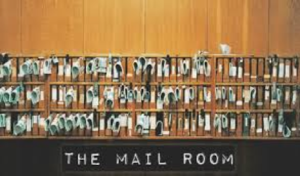 Working in the mailroom has always been considered an entry-level job. Some would say it’s the entry level for ALL entry-level jobs. Most people do not aspire to work in the mailroom; there are no mail-sorting degrees to earn. You sort the mail, open some of it and usually deliver it to someone’s desk or department where you might also pick up mail to take to a different department or to the nearest post office. Traditionally, it’s a job that requires no experience, little skill and results in low pay.
Working in the mailroom has always been considered an entry-level job. Some would say it’s the entry level for ALL entry-level jobs. Most people do not aspire to work in the mailroom; there are no mail-sorting degrees to earn. You sort the mail, open some of it and usually deliver it to someone’s desk or department where you might also pick up mail to take to a different department or to the nearest post office. Traditionally, it’s a job that requires no experience, little skill and results in low pay.
Often, it’s a summer job or a part-time job for a student. Sometimes, it’s a job for someone who can’t find another job. It generally is the lowest level of any organization.
However, there are instances of executives who started in the mailroom and made it to the boardroom. George Bodenheimer, who became the executive chairman of ESPN & ABC Sports, famously first worked in ESPN’s mailroom. Simon Cowell, of American Idol fame, worked in a record company mailroom. Ron Meyer, vice chairman of NBCUniversal, was a high-school dropout who started in the mailroom of the William Morris Agency. So did Wally Amos, the founder of the Famous Amos cookie brand. Amos rose from the mailroom to become the first African-American talent agent for that company, signing Simon & Garfunkel among others.
But these rags-to-riches stories are rare.
Working in the mailroom, though, might be more common than we think. And it’s not an entry-level position at all. Let me explain.
Recently, when meeting with a former client, I was shocked when he told me, “Most people today work in the mailroom.” He was referring to email. And I immediately realized he was right! Just like the people who work in an actual mailroom, we spend hours and hours every day writing, opening, reading, forwarding and throwing away (e)mail.
It’s more than just a waste of time, he added. Creating stress and obliterating productivity isn’t the worst of it either. “Being in the mailroom is one of the greatest destroyers of our goals,” he declared. “It’s a goal killer.”
According to a Carleton University survey, we spend a third of our time at the office and half of the time when we work from home dealing with email (most of which is not important). That’s 11.7 hours at work and 5.3 hours at home—every week—in email hell.
Often, productivity-enhancing tools tend to become productivity limiters once they are widely accepted and used (or abused perhaps). Email fits that bill. But since almost all of us must use email, I’m offering a few simple suggestions to help you manage it:
- Turn off email notification. It’s a huge distraction when you are trying to concentrate.
- Then schedule and block off dedicated time to spend dealing with email. Maybe that’s first thing in the morning. Maybe you spend a set amount of time (15 or 30 minutes) on email at 10, 2 and/or 4. Commit to that specific amount of time, and then stop when time’s up.
- Get rid of junk mail. Unsubscribe to things that don’t interest you. Spend a few minutes every day just unsubscribing from mailing lists, and soon you’ll have a much smaller inbox. These few minutes will save you lots more in the future.
- Stop being copied on emails. Instruct people to include you only if it is absolutely necessary.
- End as many of your emails as possible with, “No reply needed.”
- Send fewer emails. Try calling or texting. The more you send—the more you get.
- Remember the 4 D’s of managing email: delete, delegate, do it or defer it.
- Use Siri to transcribe your emails, when possible, to free up some time. This also works well for texts.
- Keep email content to a minimum. Some experts recommend no more than five or six sentences. After that, many people just stop reading.
- Remember, you’ll never really catch up. Email is unending; it is constant. Just do what you can, a little every day on your own terms, and don’t stress about it.
For more good tips on controlling your inbox, go to http://bit.ly/2tm2Ffm.
Recent Comments